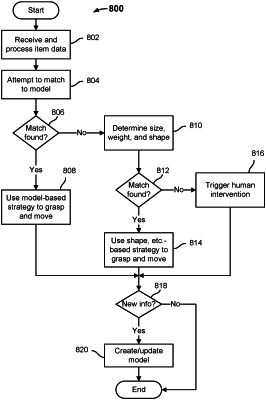| CPC B65G 47/905 (2013.01) [B25J 9/1697 (2013.01)] | 20 Claims |

|
1. A robotic system, comprising:
a communication interface; and
a processor coupled to the communication interface and configured to:
receive via the communication interface data associated with a plurality of items to be stacked on or in a destination location, wherein the data associated with the plurality of items enables a first attribute associated with an item of the plurality of items to be identified;
determine a corresponding model for each of the plurality of items, wherein the processor is configured to determine that an item-specific model does not exist for the item and in response to a determination that the item-specific model does not exist for the item, determine whether an attribute-based model exists for the item, wherein the attribute-based model for the item is determined based in part on the first attribute associated with the item;
in response to a determination that the attribute-based model exists for the item, generate based at least in part on the received data a plan to stack the items on or in the destination location based on the corresponding determined models for each of the plurality of items, wherein the plan includes a corresponding grasp strategy to pick and place each of the items based on the data associated with the plurality of items, wherein the corresponding grasp strategy to pick and place the item is based on the attribute-based model; and
implement the plan at least in part by controlling a robotic arm to pick up the items and stack them on or in the destination location according to the plan.
|